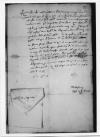List #846
Sigmund von HERBERSTEIN do Ioannes DANTISCUSGrub, 1531-08-17
| odebrano Brussels, [1531]-09-06 Rękopiśmienne podstawy źródłowe:
Pomocnicze podstawy źródłowe:
Publikacje:
| ||||||||||
Tekst + aparat krytyczny + komentarzZwykły tekstTekst + komentarzTekst + aparat krytyczny
Reverendissimo domino, domino
Reverendissime Domine, Domine observandissime. Post servitiorum meorum commendationem.
cf.
Ex aedibus
Eiusdem Vestrae Reverendissimae Dominationi deditissimus
[1 ] After returning from his mission to Cracow, Herberstein traveled via České Budějovice (Ger. Budweiss) and Vienna to his Klamm Castle near Schottwien am Semmering (see cf.
[2 ] See cf. Sigmund Herberstein, Sigmunds von Herberstein Selbstbiographie, ed. by Th. G. von Karajan, Wien, 1855, series: Fontes Rerum Austriacarum I Abteilung, Scriptores Band 1 ⌊HERBERSTEIN 1855cf. Sigmund Herberstein, Sigmunds von Herberstein Selbstbiographie, ed. by Th. G. von Karajan, Wien, 1855, series: Fontes Rerum Austriacarum I Abteilung, Scriptores Band 1 ⌋, p. 300, with a description of the journey from Schottwien to Graz in 1532
[3 ] Probably a reference to the Viennese postmaster of the court post (Hofpost) of Ferdinand I, established in 1523 under the administration of Gabriel von Taxis, or to the Viennese postmaster of the imperial post, whose general administrator was Johann Baptista von Taxis (c. 1470-1541), appointed by Emperor Charles V in 1520 (cf. cf.
[4 ] See cf.
[6 ] In September 1522, the wedding of Herberstein and Helena von Graswein took place in Grub. The estate and residence at Grub bei Piber (described as a Schloss in 1580) remained in Helena von Graswein’s hands after the death of herfirst husband Wolf von Saurau, probably as pledged security for her dowry, and one can assume it was used by her at least until 1542. Apart from records in the Styrian land registers, this residence’s location near Piber (and not, as the publisher of Selbstbiographie suggested, near Weiz – northeast of Graz)is also suggested by Herberstein’s itineraria from the years 1522, 1531 and 1532 in his Selbstbiographie (see cf. Die Urbare, urbarialen Aufzeihnungen und Grundbücher der Steiermark. Gesamtverzeichnis mit Ausschluss der Herrschaften und Gülten der ehemalig Untersteiermark, unter Berücksichtigung landschaftlicher Steuerregister, der 'Gültschätzung 1542' und der Theresianischen Steuerrektifikation, vol. Band 3/I: A-J, Graz, 1967 ⌊Pichler III/1cf. Die Urbare, urbarialen Aufzeihnungen und Grundbücher der Steiermark. Gesamtverzeichnis mit Ausschluss der Herrschaften und Gülten der ehemalig Untersteiermark, unter Berücksichtigung landschaftlicher Steuerregister, der 'Gültschätzung 1542' und der Theresianischen Steuerrektifikation, vol. Band 3/I: A-J, Graz, 1967 ⌋, No. 413, p. 459-460; cf. Sigmund Herberstein, Sigmunds von Herberstein Selbstbiographie, ed. by Th. G. von Karajan, Wien, 1855, series: Fontes Rerum Austriacarum I Abteilung, Scriptores Band 1 ⌊HERBERSTEIN 1855cf. Sigmund Herberstein, Sigmunds von Herberstein Selbstbiographie, ed. by Th. G. von Karajan, Wien, 1855, series: Fontes Rerum Austriacarum I Abteilung, Scriptores Band 1 ⌋, p. 263, 295, 300)

